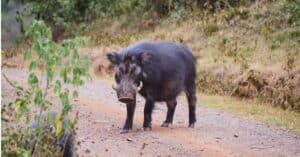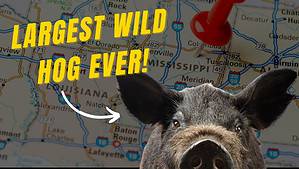Potbellied pigs – also called pot belly pigs or Vietnamese pot-bellied pigs – are one of the smallest domestic pig breeds with a low-hanging belly and very short legs. They have an exaggerated pot belly just as the name implies.
These pigs have quite a lot of interesting characteristics, including their continuous growth. Most people buy potbellied pigs as pets thinking they’d always remain small, only for them to be surprised later by the pig’s unending growth!
But what about their eating habits? What are their food preferences, and how much do they normally eat? How do you determine if your potbellied pig is obese?
This article will give you some fun facts and insights about what potbellied pigs love eating and how you can improve their food to enhance their general health. Let’s get started!
What Do Pot Belly Pigs Eat?
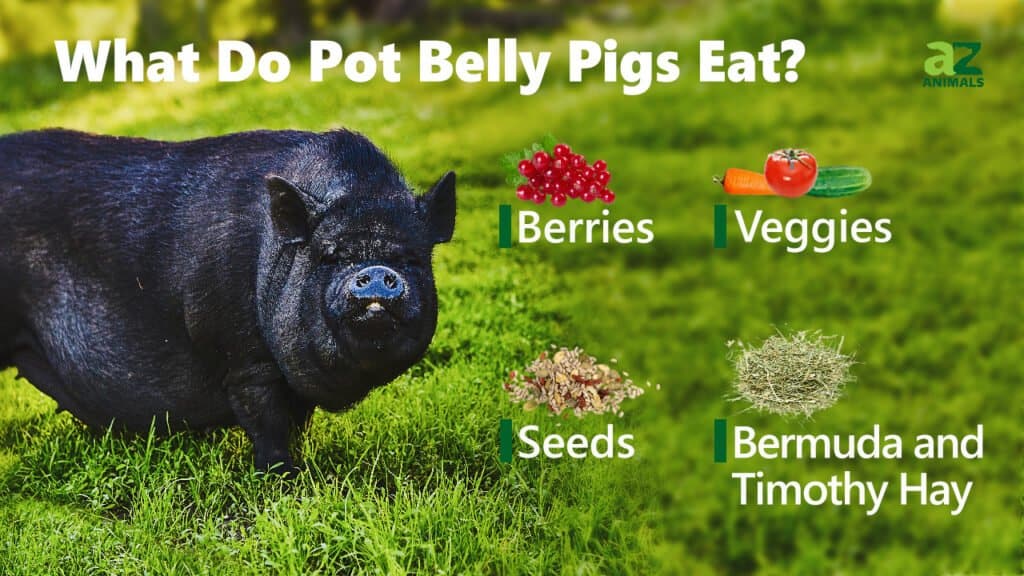
Like all other pigs, potbellied pigs are generally omnivores, meaning that they eat both small animals and plants. Their diet consists of:
- Seeds
- Raw eggs
- Worms
- Berries
- Insects
- Veggies
- Nuts
- Roots
They can also eat specially formulated pellet diets. This is a good quality diet that is low in calories and high in fiber.
Potbellied pigs also enjoy occasional treats, such as unbuttered popcorn, pretzels, biscuits, fruits, and vegetables. Just avoid feeding them too many fruits and other sugary treats because they may possibly harm their health.
How Much Do Potbellied Pigs Eat?
The amount of food required to feed your potbellied pig generally depends on the quality of food and the weight of the pig. A diet for adult potbellied pigs should constitute the following:
- 25% of the non-starchy vegetables, such as carrots and cucumbers.
- ½ a cup of high-quality pellets for pot belly pigs weighing 25 pounds. A 75-pound pot belly pig may eat one to two cups of the maintenance ratio a day.
- A piece of chewable multivitamin each day accompanied by two spoonfuls of fruit two to three times a week.
- Roots from untreated soils. This gives pot belly pigs additional iron and selenium.
- Bran or hay to increase fiber consumption that will in turn aid digestion in pot belly pigs.
As for the young piglets above the age of 2 to 3 months, you can start introducing commercial starter diets. Before 2 months, their stomachs are not fully developed to digest starter food. Until then, they will need to rely on their mother’s milk. You may opt for a commercial milk replacer if their mother does not produce sufficient milk.
How Often Do Pot Belly Pigs Eat?
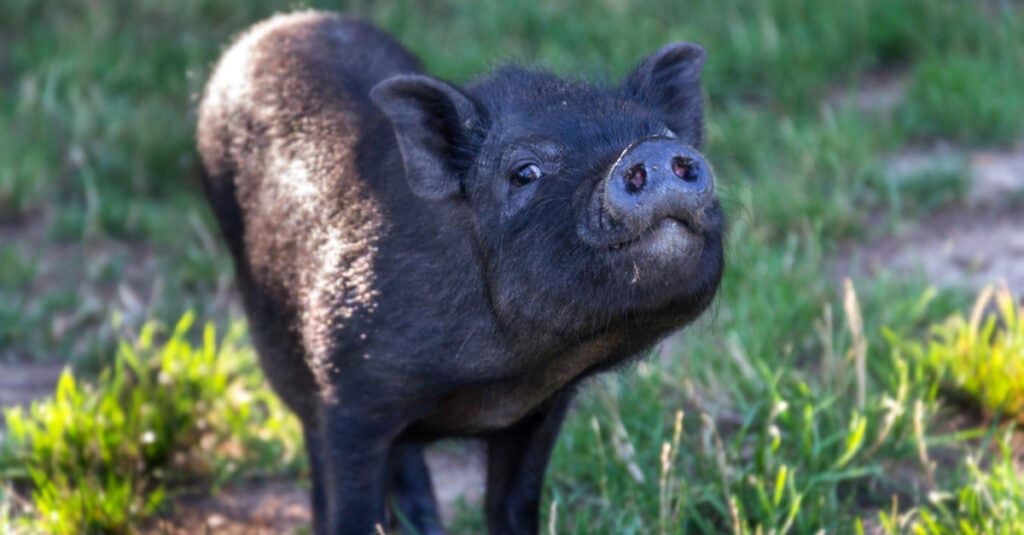
©josefkubes/Shutterstock.com
Potbellied pigs really love to eat. Which is why we should always pay careful attention to the amount and quality of food that you feed them. They should be fed twice a day with a proper diet.
As opposed to adult potbellied pigs, piglets should be fed ad libitum, that is they should be given as much food as they want as many times as possible. You may need to reduce the food gradually once they are a year old. But remember that not all pigs are different. So, feeding them will depend on their activity and metabolism rate.
What Should You Not Feed Potbellied Pigs?
Many people believe that potbellied pigs can feed on a wide variety of foods (sometimes even garbage!) and still feel okay. However, this is not true because certain foods and plants are poisonous for potbellied pigs. Some of the toxic foods and plants as outlined by the Southern California Association of Miniature Potbellied Pigs include:
- Green potatoes
- Cabbage roots and seeds
- Chocolate
- Too much biscuits
- Too much fruits and fruit juices
- Apple seeds
- Avocado skin and seed
- Potato leaves, berries, and stem
- Tomato leaves and vines
Things to Consider When Feeding Your Pot Belly Pigs
- Avoid feeding your pot belly pigs swine or hog feed as they might have been formulated to serve different purposes, such as boosting growth within minimal time. Consider buying pot belly pigs pellets that are specially formulated for them.
- Don’t feed them cat and dog foods because they contain too much protein. Excessive protein may affect the availability of amino acids in pot belly pigs, which in turn affects their growth.
- Avoid feeding them human processed foods as they are normally high in salt and sugars.
- Don’t feed pot belly pigs too much starch because they are prone to obesity. Obesity may in turn give rise to many other health problems in addition to joint and foot issues.
- Make sure that the foods are fresh. Clean their house after feeding to avoid build-up of moulds that your pot belly pig might later consume.
- Offer pot belly pigs fresh water as often as possible.
- Pot belly pigs are not strict herbivores, but you might as well allow them to graze on grass so that they can get the necessary minerals from the roots of the plants.
What Do Baby Pot Belly Pigs Eat?
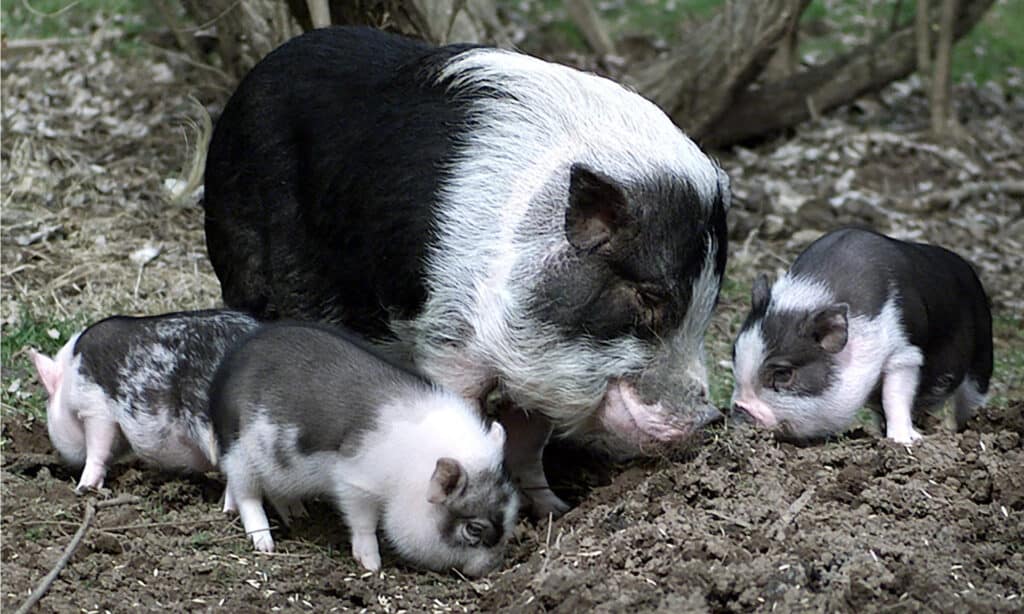
Potbellied piglets should nurse until they are 6 – 8 weeks old.
©Wendy M. Simmons/Shutterstock.com
Sows normally breastfeed their newborn piglets. It’s important that piglets receive colostrum within 24 hours after birth. Failure to do so can result in a high mortality rate among the piglets caused by weakened immunity and starvation.
Young piglets should be fed a commercial pig starter diet which includes the following 1/2 cup of food per 25 pounds of pig. They should not be fed cabbage roots or seeds, broccoli, avocado skin and pin, and more. These foods should not be consumed by your pig and are considered poisonous plants.
However, there are instances whereby the sow dies or doesn’t produce enough milk for the piglets. In this case, you will have to bottle feed the piglets with commercially available milk replacers.
You may begin weaning towards the end of the 8th week by gradually introducing solid starter food. Potbellied pigs should nurse their young ones until they are 6 to 8 weeks old.
Final Thoughts
Potbellied pigs are easily overfed because they’ll never say no to more and more food. It’s important that you monitor your pig’s weight to ensure that they are not overweight. Some of the signs you should look for to determine whether your pig is overweight include a fat roll covering their eyes.
You might also need to consult with your vet to know the ideal weight of your potbellied pig. Besides, the vet may advise you about their diet, together with the quality and quantity of food. Remember to feed your potbellied pig balanced food that is free from toxic elements.
Bonus: Can Potbellied Pigs Be House Trained?
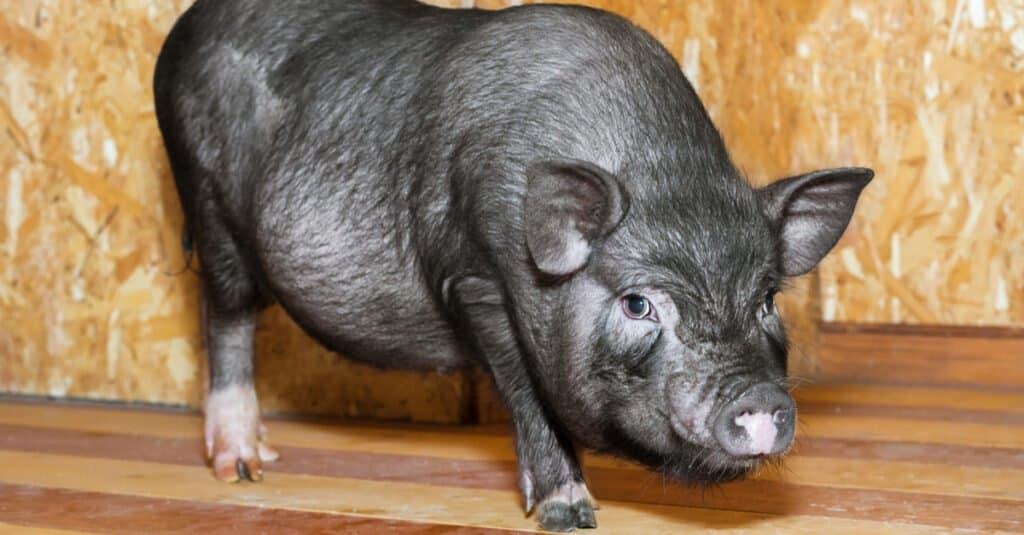
Potbellied pigs are intelligent animals and relatively easy to house train.
©Anton Watman/Shutterstock.com
House-training a potbellied pig is similar to training a puppy! Here’s how to train your new piglet:
- Confine your pig to a small area when not directly supervising her.
- Take your pig outside every 2 hours and upon waking and after meals.
- Come up with a command to use when you want your pig to urinate or defecate.
- Use lots of praise when your pig potties outside and give him a treat.
- Establish a routine for eating and going outside to help your pig understand the idea of going outside to potty.
- Don’t punish your pig if she has an accident! If you catch her in the act – say no and take her outside immediately.
- Use baby gates to limit your pig’s access to the house until he is trained.
- Avoid using newspapers or peepads.
- If your pig starts having accidents during training – back up and start over.
Spaying and neutering will decrease marking behavior and will make training easier. Have patience – your little piglet is totally capable of being house-trained!
The photo featured at the top of this post is © Anton Watman/Shutterstock.com
Thank you for reading! Have some feedback for us? Contact the AZ Animals editorial team.




